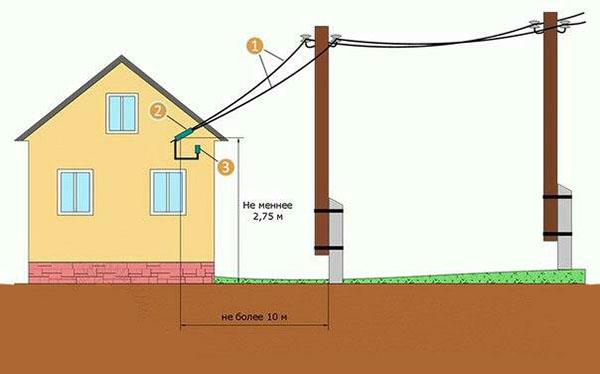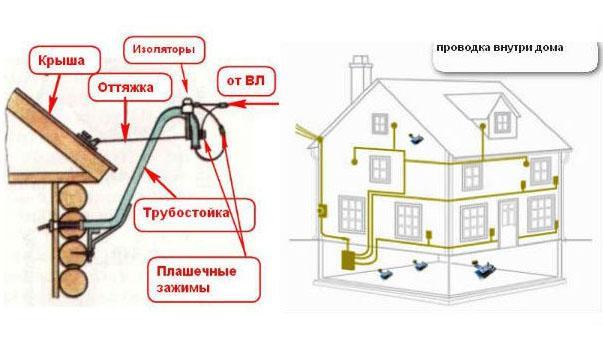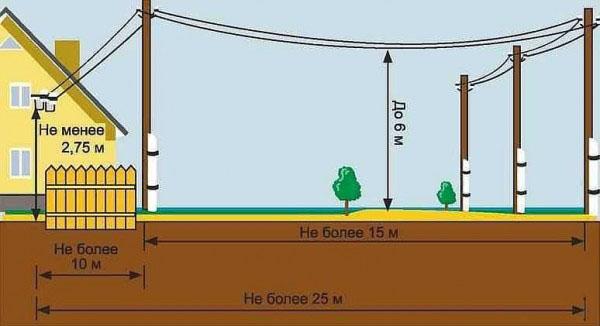Making an electricity connection to the house from the pole
 Electricity in residential areas of cities and villages is carried out by wires stretched on poles, but the old wiring fails and needs to be replaced. Similar operations are performed during the construction of a new house or summer cottage and, if necessary, connect the electricity to the house from the pole. The wiring diagram should indicate the type of cable and the way it is laid.
Electricity in residential areas of cities and villages is carried out by wires stretched on poles, but the old wiring fails and needs to be replaced. Similar operations are performed during the construction of a new house or summer cottage and, if necessary, connect the electricity to the house from the pole. The wiring diagram should indicate the type of cable and the way it is laid.
Cable routing methods

According to the old rules of the PUE, the input of electricity into the house was carried out by separate wires that were drawn through the air to the house. Now the rules have changed:
- with air laying of wires, the SIP cable is installed from the pole to the house;
- when laying underground, an armored cable is used to connect the house from the table - VBbShv cable.
To connect, you must disconnect the trunk line running along the poles. According to the standards in force in Russia, such work is performed by specialized organizations.
How to install a cable through the air
 Over-the-air insertion is fast, at no additional cost, but this cable can be cut off by branches or falling trees, or cars. In addition, the following requirements must be met:
Over-the-air insertion is fast, at no additional cost, but this cable can be cut off by branches or falling trees, or cars. In addition, the following requirements must be met:
- The height of the cable supply to the building is more than 2.75 m.
- The distance between the wire and the carriageway must be more than 6 m at the lowest point of the sag.
- Without an intermediate post, the cable can be stretched up to 10 meters. The distance from the additional post to the highway is no more than 15 m.
The figure shows a diagram of connecting electricity to a house from a pole through the air and the distance between the supports. If the length of the electricity input to a private house exceeds 25 m, then this is no longer a cable supply, but the laying of trunk lines on poles for electrical wires, which is carried out by the relevant organizations.
Cable entry into the house through the wall in a wooden house is carried out in a steel pipe. When entering a brick building, the pipe may be plastic. The cable is laid to the shield in a hidden or open way and is closed with a plastic or steel pipe at a height of less than 2 m.
If the height of the structure is insufficient, the cable entry for the overhead line in a country house or a private house is carried out through a straight or curved (gander) rack. They differ in shape and wall mounting:
- The direct entry is fixed to the wall of the house and the cable goes through the roof. Later, it joins with a wire entering the building. In this case, the ingress of moisture into the pipe is not dangerous.
- The inlet pipe is bent and goes through the wall of the house. In this case, the cable goes in one piece from the pole through the gander for electricity to the input machine or electric meter.
 The cross-section and material of the cable depends on its length:
The cross-section and material of the cable depends on its length:
- up to 10 m - copper cable 4 mm²;
- from 10 to 15 m - copper wires 6 mm²;
- cross-section of aluminum cable not less than 16 mm².
Most often, a cable with aluminum conductors is used because of the lower price.
Electric wire laying
 There are two options for cable routing:
There are two options for cable routing:
- Outdated. A steel cable or wire is pulled along the track. An insulated cable is tied to them with the help of special fasteners.
- Modern. Use self-supporting insulated wire SIP. It stretches without additional ropes and is held in place by strong insulation or internal steel wire.
Such a cable is the most common when entering a house.Its connection is made with special fittings, which include tensioners, fasteners and porcelain or plastic insulators. These devices are made less durable than the cable itself and when snow sticks or trees fall, the reinforcement is destroyed and the conductive conductors fall to the ground. The cable itself and its insulation remain intact. When eliminating the accident, it is enough to change the fasteners and insulators.
The picture shows an outdated method of input with four single-core wires stretched over porcelain cups and how to fix the self-supporting insulated wire on the wall of the house.
How to make an underground (trench) connection of electricity to a house from a pole
 In addition to the air, there is another scheme for connecting electricity to the house from the pole - underground. With the underground method of laying, a section of the cable located in the air, at a height of 2 m from the ground, is protected by a steel pipe that goes down to the bottom of the trench. The laying depth is:
In addition to the air, there is another scheme for connecting electricity to the house from the pole - underground. With the underground method of laying, a section of the cable located in the air, at a height of 2 m from the ground, is protected by a steel pipe that goes down to the bottom of the trench. The laying depth is:
- if a pipe is laid in a trench or a cable is covered with a concrete or asbestos-cement slab - 0.7 m;
- the cable, simply covered with earth, is laid deeper than 1 m.
The electricity supply to the house underground is carried out through the foundation or through the outside, through the air. The site located on the wall up to a height of 2 meters is closed with a pipe or box.
With a current of up to 25A and a three-phase input with a power of up to 15 kW, the cross-section of such a wire is selected according to the permissible heating, but for reliability, an armored copper cable VBbShv with a cross section of 10 mm² is usually installed.
The foundation of a wooden building is considered non-combustible, therefore plastic pipes are allowed. They are installed when building a house.
If the building collapses, the cable can be damaged. Therefore, entry under the foundation is prohibited. It is also forbidden to lay cables under the road.
Making input through the wall
The cable leading to the house must be brought inside. It is laid through the wall in a pipe filled with an easily destructible cement-sand mixture or similar material.
Electrical cable entry through a wall in a wooden structure
 Most often, the wire enters the house through the attic. When laying an aluminum wire near a wooden house, it must be replaced with a copper one. As a rule, for this, a VVGng cable with non-combustible insulation is used. This is done in accordance with PUE clause 2.1.70, which prohibits laying aluminum wires in the attic.
Most often, the wire enters the house through the attic. When laying an aluminum wire near a wooden house, it must be replaced with a copper one. As a rule, for this, a VVGng cable with non-combustible insulation is used. This is done in accordance with PUE clause 2.1.70, which prohibits laying aluminum wires in the attic.
 Conductive conductors on the street are connected with terminal blocks in sealed boxes. In the absence of a terminal block, the connection is made with a bolt, and a third washer is placed between the copper and aluminum. The figure shows how to connect SIP and copper cable.
Conductive conductors on the street are connected with terminal blocks in sealed boxes. In the absence of a terminal block, the connection is made with a bolt, and a third washer is placed between the copper and aluminum. The figure shows how to connect SIP and copper cable.
Do not twist the connection.
Entering an electric cable into a wooden house is carried out in a steel pipe with a diameter of 4 times the outer insulation. The minimum wall thickness is standardized by SP 31-110-2003 and depends on the cable cross-section:
- up to 4 mm² wall not less than 2.8 mm;
- up to 10 mm² - 3.2 mm.
A pipe is installed with a slope to the street. This prevents water from leaking into the interior. Additionally, the pipe is sealed with rubber plugs.
To avoid damage to the insulation, the pipe ends are cleaned from the inside of irregularities with a file.
Performing input to dry and damp rooms
 Entering into dry and wet rooms is done differently. This is associated with the need to protect the pipe and cable in it from moisture.
Entering into dry and wet rooms is done differently. This is associated with the need to protect the pipe and cable in it from moisture.
Despite the fact that the connection of electricity from the pole to the house is carried out by specialized organizations, you need to know how to do this work. This allows you to take part in the development of the project and help you choose the best option for laying the cable and control the connection.
Good day!
A shield with a counter, automatic devices and an outlet is installed on the post. The house is 30m from it, 5 kW is allocated.Is it possible to bring a cable into the house in a metal hose with PVC over a fence or necessarily in the ground? And which cable is needed?